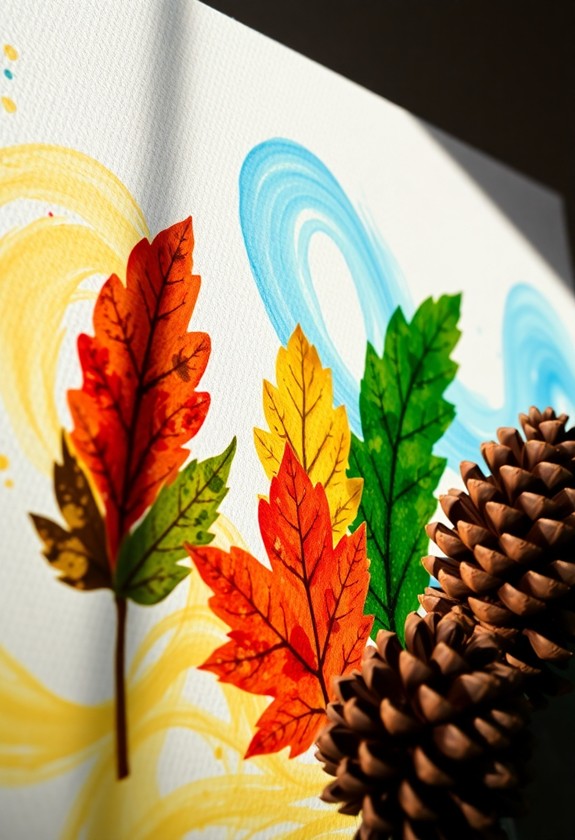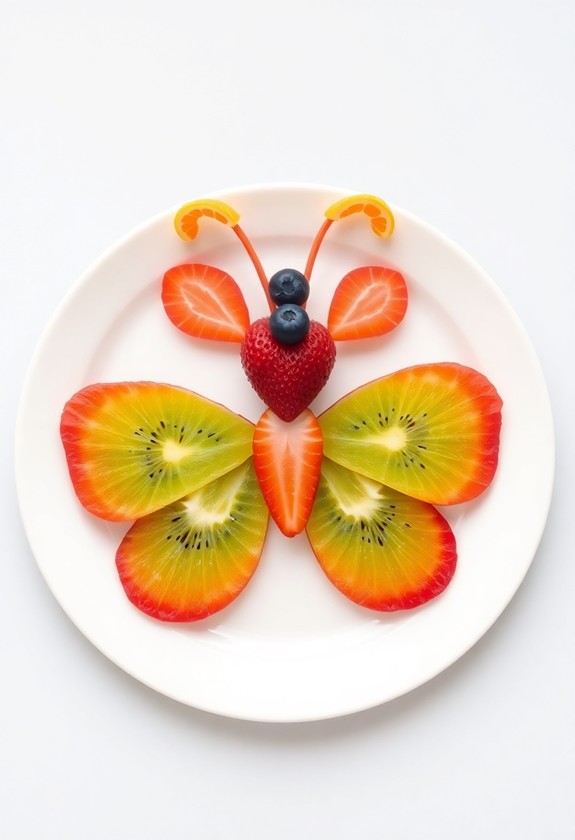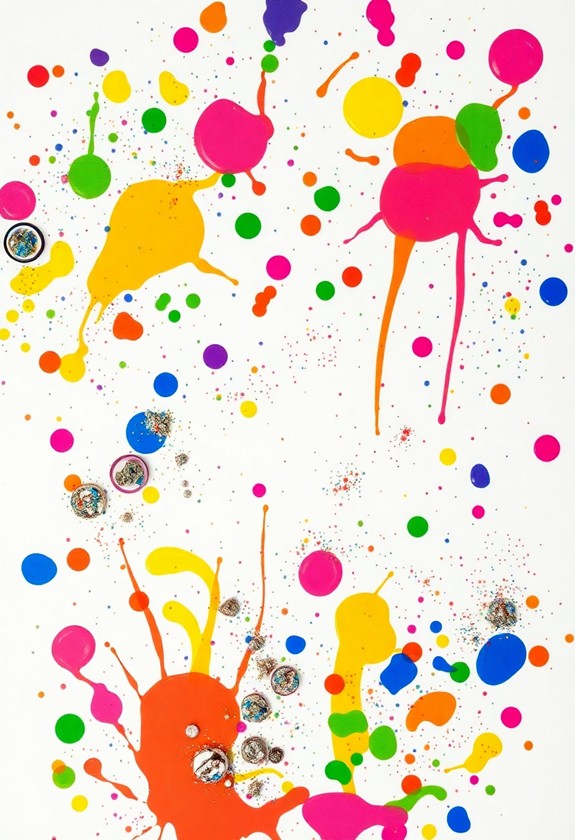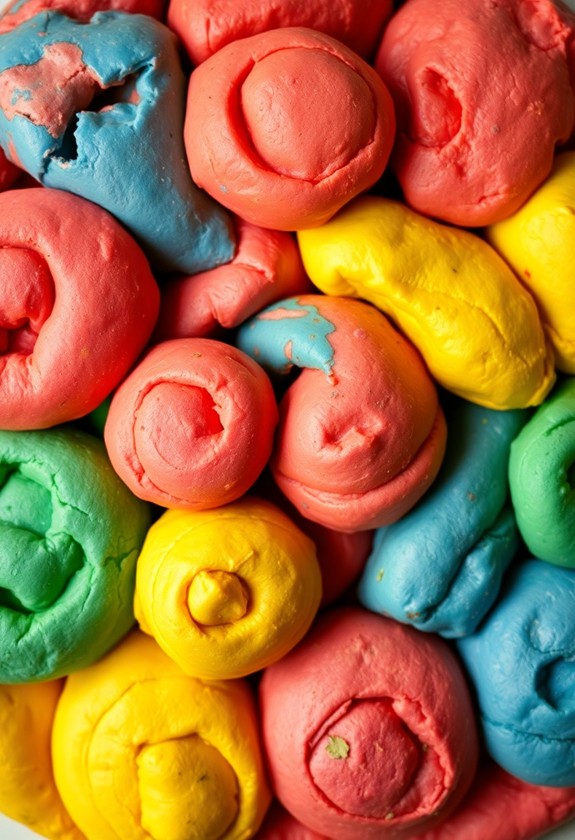Immerse yourself in nature-inspired sensory art with your little ones! Start by gathering leaves, twigs, and pebbles on a fun scavenger hunt. Create textured leaf rubbings to reveal intricate patterns, or paint pine cones for a unique 3D canvas. Make a nature collage by gluing found objects onto cardboard, or sculpt with mud and clay for hands-on fun. For a magical touch, craft flower petal suncatchers that'll catch the light! These activities aren't just creative – they're a fantastic way to investigate textures, colors, and the great outdoors. Plus, they'll help your kiddos develop a deep appreciation for nature. Ready to ignite their inner artists?
Creative Highlights
- Explore nature through a scavenger hunt, collecting materials for sensory art projects.
- Create textured leaf rubbings to reveal intricate details and patterns.
- Paint pine cones with vibrant colors to explore textures and encourage creativity.
- Assemble nature collages using gathered materials to engage in sensory exploration.
- Craft flower petal suncatchers to capture nature's beauty and create colorful reflections.
Gathering Natural Materials
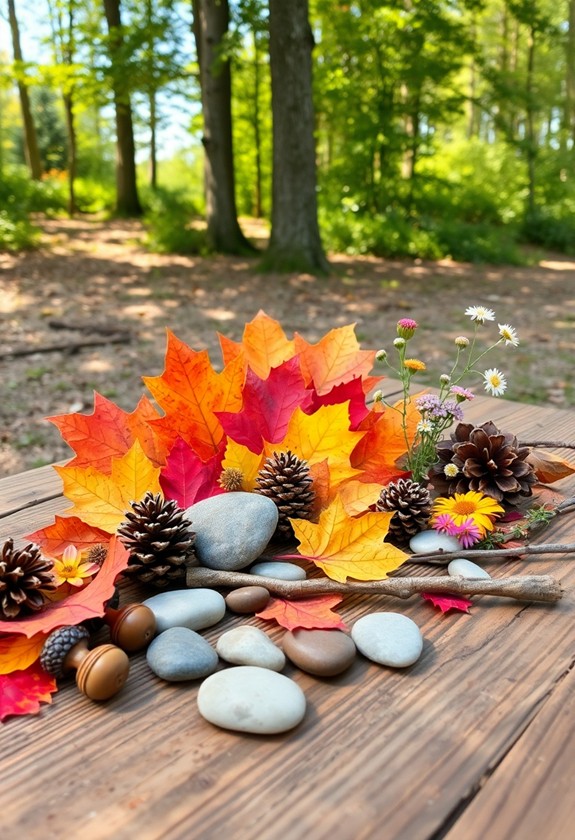
Head out into nature to gather a diverse array of materials for your sensory art project. It's time for a scavenger hunt! Look for:
- Leaves in different shapes and colors
- Twigs and bark pieces
- Smooth pebbles and rough rocks
- Soft moss and fluffy dandelion seeds
- Fragrant flowers and aromatic herbs
Don't forget to bring a bag or basket to carry your treasures! As you investigate, encourage your little ones to use their senses. Feel the textures, smell the scents, and listen to the sounds of nature. This sensory learning approach engages toddlers with lively colors, shapes, and textures, enhancing their overall experience. But remember, we're nature's guests, so let's be respectful:
- Only take what you need
- Don't disturb living plants or animals
- Leave no trace behind
This outdoor adventure is not just fun, it's educational too! Your kids will learn about different plants, textures, and colors as they connect with nature. Let the wild rumpus begin!
Textured Leaf Rubbings
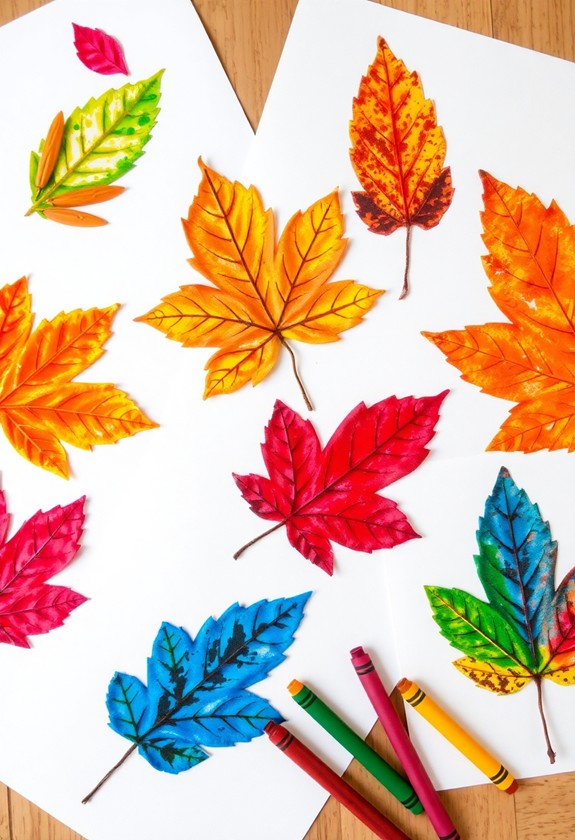
Frequently, the simplest activities can yield the most fascinating results. Leaf rubbings are a perfect example! This classic craft is not only fun but likewise a great way to examine textures and shapes found in nature.
Here's how to create your own leaf rubbing masterpiece:
- Place a leaf under a sheet of paper, vein-side up
- Hold the paper steady
- Gently rub a crayon or colored pencil over the paper
Watch in amazement as the leaf's intricate details magically appear! It's like nature's own printing press. Try different leaves for unique patterns – oak leaves, maple leaves, or even ferns. Mix and match colors to create a leafy rainbow!
But wait, there's more! Turn your rubbings into art projects:
- Make leaf rubbing collages
- Create greeting cards
- Design bookmarks
Let your imagination run wild and "leaf" your mark on the art world!
Pine Cone Painting
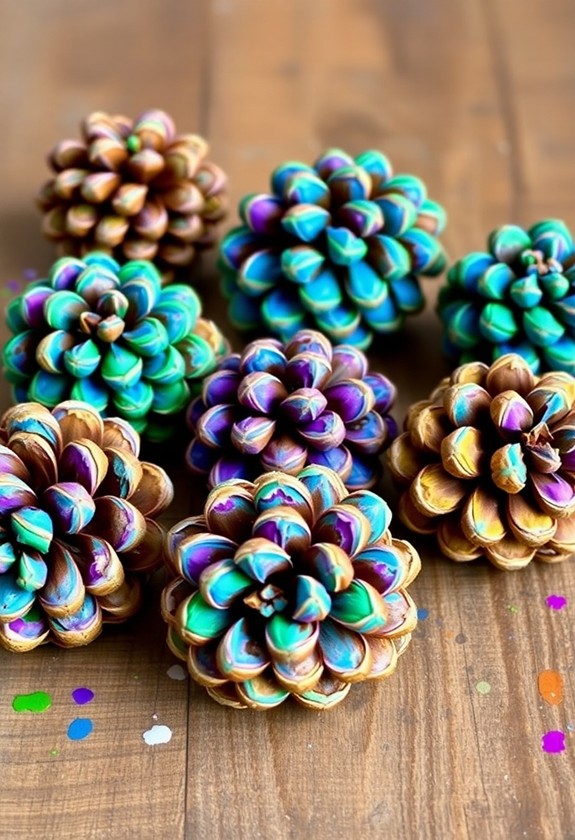
Pine cones offer a unique natural canvas for creative painting projects. They're perfect for little hands to investigate texture during creating lively art! Here's how to get started:
1. Gather pine cones from your backyard or local park.
2. Clean them gently with a soft brush.
3. Set up a painting station with:
- Acrylic paints in various colors
- Small brushes
- Water cups
- Paper plates for paint mixing
This eco-friendly craft option promotes environmental awareness during encouraging creativity. Consider discussing the importance of using natural materials in art projects with your little ones.
Now, let the fun begin! Encourage your kids to paint each scale of the pine cone. They can create patterns, use different color combinations, or even make tiny forest creatures! The possibilities are endless.
As they paint, ask them about the textures they feel. Is it rough or smooth? Bumpy or flat? This sensory experience will really stick with them, making art time a blast!
Nature Collage Creation
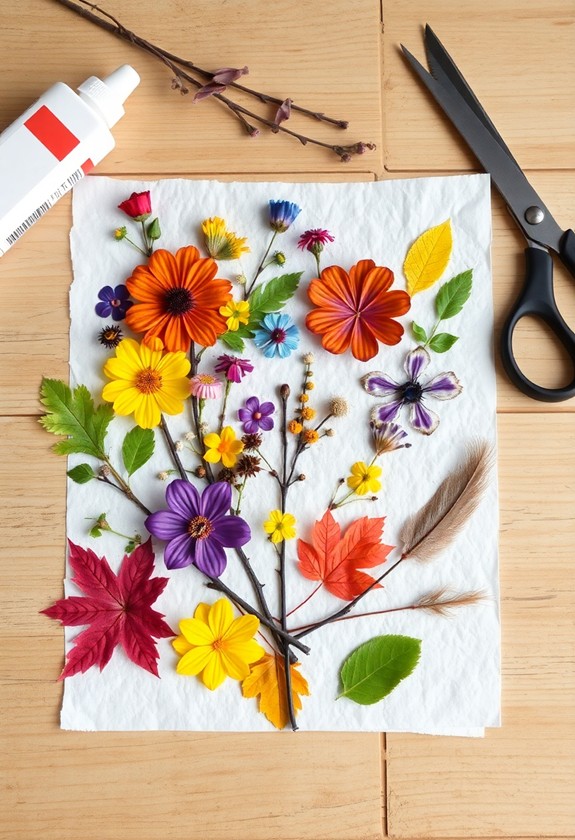
From leaves to twigs, nature offers an abundance of materials for creating stunning collages. Get ready for a fun-filled adventure in art and nature exploration! Here's how to make your very own nature collage:
- Gather your supplies:
- Cardboard or heavy paper
- Glue
- Natural materials (leaves, petals, bark, etc.)
- Clay or mud (the squishier, the better!)
- Natural objects like pebbles, twigs, and leaves
- Your imagination!
This activity promotes cognitive development through creative thinking and sensory exploration of textures and colors. It's additionally an excellent way to engage toddlers in a short, focused craft session.
2. Head outdoors and collect your treasures! Look for items with different textures, colors, and shapes.
3. Arrange your findings on the cardboard. Get creative! Make patterns or create a picture.
4. Once you're happy with your design, glue everything in place.
5. Let it dry, and voila! You've made a masterpiece!
This activity is a great way to "leaf" your mark on the art world! Plus, it's a wonderful opportunity to bond with nature and release your creativity. Happy collaging!
Mud and Clay Sculptures

Now that we've explored the world of nature collages, let's get our hands dirty with mud and clay sculptures. It's time to squish, mold, and shape natural materials into awesome 3D creations!
Here's what you'll need:
Start by rolling your clay into a ball. Then, let your creativity run wild! You can:
- Make a mini animal sculpture
- Create a nature-inspired face
- Build a tiny fairy house
Don't forget to press natural objects into your sculpture for extra texture and pizzazz. Leaves make great wings, and pebbles are perfect for eyes!
When you're done, let your masterpiece dry in the sun. Voila! You've just made a mud-nificent work of art!
Flower Petal Suncatchers
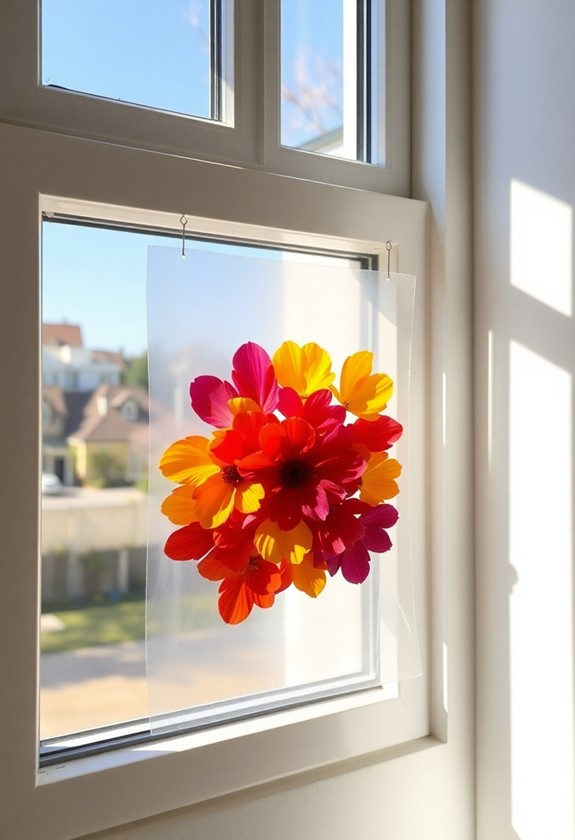
Sunlight twirls through delicate petals in our next nature-inspired art project: flower petal suncatchers. Get ready to capture nature's beauty in a whole new way!
Here's what you'll need:
- Clear contact paper
- Colorful flower petals
- Scissors
- String or ribbon
Let's get crafty:
- Cut two circles from contact paper.
- Peel off one backing and stick petals to the sticky side.
- Remove the other backing and press the circles together.
- Trim the edges and punch a hole at the top.
- Thread string through the hole and hang it up!
Watch as sunbeams sway through your creation, casting magical shadows and bringing a burst of natural color to any room. It's like having a mini-rainbow factory right at home! Plus, you'll preserve those pretty petals for petal-fection!
Curious Little Questions
How Can I Preserve the Nature-Inspired Art Projects for Long-Term Display?
Let's keep those nature-inspired masterpieces blooming forever! To preserve your little one's art, try these magical tricks:
- Seal it with clear spray or mod podge – it's like giving your art a protective hug!
- Frame it behind glass – a window to your child's creativity
- Laminate flat pieces – they'll be tough as bark!
- Take high-quality photos – capture the moment digitally
- Create a scrapbook – a forest of memories in one place
With these techniques, you'll have a lasting gallery of nature's wonders, touched by your child's imagination!
Are There Any Safety Concerns When Using Natural Materials for Art Projects?
Yes, there are some safety concerns when using natural materials for art projects! Keep these tips in mind:
- Always supervise your little artists!
- Avoid toxic plants or berries – stick to safe, known materials
- Watch out for sharp edges on sticks or shells
- Be aware of allergies, especially with nuts or pollen
- Clean materials thoroughly to remove dirt and bugs
- Don't use moldy or decaying items
With these precautions, you'll be all set for some natural artistic fun! Let's get creative and stay safe!
What Age Group Is Best Suited for These Nature-Inspired Art Activities?
Let your imagination bloom like a wildflower! Nature-inspired art activities are perfect for kids of all ages, but they're especially magical for those between 3 and 12. Little ones (3-6) will love the sensory exploration, whereas older kids (7-12) can get creative with more complex projects. But don't let age limit you! Even teens and adults can join in on the fun. Remember, it's not about perfection – it's about connecting with nature and letting your creativity soar!
How Can I Incorporate Learning About Ecosystems Into These Art Projects?
You can make ecosystems come alive through art! Try these fun ideas:
- Create a diorama of different habitats using natural materials
- Paint a food chain with leaves and berries as stamps
- Build a mini-ecosystem in a jar, layering soil, plants, and tiny critters
- Make animal puppets and act out their roles in nature
- Design a mural showing how animals and plants interact
It's a blast to learn as you create! Your little ones will be ecosystem experts before you know it.
Can These Activities Be Adapted for Children With Sensory Sensitivities?
You can easily adapt these activities for kids with sensory sensitivities. Here are some quick tips:
- Use gentle, natural materials like soft leaves or smooth pebbles
- Offer noise-cancelling headphones for quieter experiences
- Provide gloves for those who don't like messy textures
- Create a calm, low-light environment
- Allow breaks and quiet spaces
- Use unscented materials to avoid overwhelming smells

